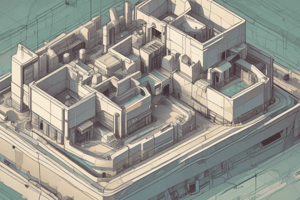Podcast
Questions and Answers
When did technical drawing first emerge as a distinct discipline?
When did technical drawing first emerge as a distinct discipline?
- During the Renaissance period (correct)
- In the 20th century with the advent of CAD software
- In ancient Egyptian times
- During the Stone Age
Which of the following was NOT a significant development in the evolution of technical drawing?
Which of the following was NOT a significant development in the evolution of technical drawing?
- The development of descriptive geometry
- The use of three-dimensional models
- The introduction of linear perspective
- The invention of the printing press (correct)
What was the primary purpose of early technical drawings?
What was the primary purpose of early technical drawings?
- To record historical events
- To document artistic expressions
- To create decorative designs
- To facilitate communication and problem-solving (correct)
Which of the following techniques became the backbone of technical drawing, enabling precise representation of 3D objects in 2D?
Which of the following techniques became the backbone of technical drawing, enabling precise representation of 3D objects in 2D?
What technology revolutionized the field of technical drawing by enabling more precise and efficient drawings?
What technology revolutionized the field of technical drawing by enabling more precise and efficient drawings?
Which of the following is NOT a purpose of technical drawing?
Which of the following is NOT a purpose of technical drawing?
Which best practice is NOT mentioned for creating effective technical drawings?
Which best practice is NOT mentioned for creating effective technical drawings?
Which of the following is an advantage of technical drawing in international collaboration?
Which of the following is an advantage of technical drawing in international collaboration?
What should guide the choices about perspective, scale, and level of detail in a technical drawing?
What should guide the choices about perspective, scale, and level of detail in a technical drawing?
Which statement best reflects the role of technical drawing in problem-solving and troubleshooting?
Which statement best reflects the role of technical drawing in problem-solving and troubleshooting?
Flashcards are hidden until you start studying
Study Notes
The Art and Science of Technical Drawing
Technical drawing has been an integral part of human civilization since ancient times, evolving from simple sketches to highly precise diagrams and 3D models that facilitate communication, innovation, and problem-solving across diverse fields. Let's dive into the evolution, applications, and best practices of this versatile visual language.
Evolution of Technical Drawing
Technical drawing has its roots in the agricultural era, where early humans needed to document their inventions and improvements in tools and machinery (). The first recorded technical drawing dates back to 30 BC, created by the Egyptians (). However, it wasn't until the Renaissance period that technical drawing emerged as a distinct discipline, fueled by innovators like Leonardo da Vinci, who combined science and artistry in his sketches, and Filippo Brunelleschi, who introduced linear perspective into architecture and machinery sketches ().
As technology advanced, descriptive geometry and orthographic projections became the backbone of technical drawing, enabling engineers and architects to represent three-dimensional objects in two dimensions with remarkable precision (). Over time, these traditional techniques gave way to computer-aided design (CAD) software, which revolutionized the field with its ability to produce more precise and efficient drawings ().
Applications of Technical Drawing
Technical drawing serves multiple purposes across industries, including:
- Communication: By translating complex ideas into visual formats, technical drawing facilitates understanding among team members, stakeholders, and customers ().
- Simplification: Technical drawings reduce complex concepts into comprehensible diagrams, making them accessible to non-experts and fostering collaboration ().
- Standardization: Consistent symbols, line weights, views, and shapes help ensure that information is conveyed universally, regardless of the viewer's language or background ().
- Problem Solving and Troubleshooting: Engineers and technicians rely on technical illustrations for maintenance, repair, and diagnostic purposes ().
- Safety and Training: Technical drawings play a vital role in promoting safety by providing clear visual instructions and warnings ().
- International Collaboration: As a global language, technical drawing bridges communication gaps between teams working across different languages and cultures ().
Best Practices in Technical Drawing
To create effective technical drawings, consider these best practices:
- Define your purpose: Understand what you want to communicate before beginning your drawing. This will guide your choices about perspective, scale, and level of detail ().
- Maintain accuracy: Ensure that all measurements are precise and consistent with industry standards ().
- Use appropriate symbols and conventions: Standardized symbols help ensure clarity and ease of interpretation ().
- Consider the audience: Design your drawing based on who will read it and what they need to understand ().
- Keep it simple: Avoid clutter and complexity; focus on conveying essential information clearly ().
As technology continues to evolve, technical drawing will adapt accordingly, incorporating new tools and techniques to meet the changing needs of its users. Regardless of the medium, this ancient art form remains a cornerstone of innovation and understanding in our increasingly complex world.
Studying That Suits You
Use AI to generate personalized quizzes and flashcards to suit your learning preferences.




